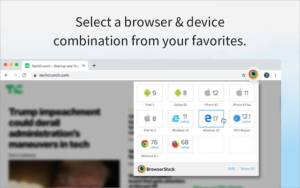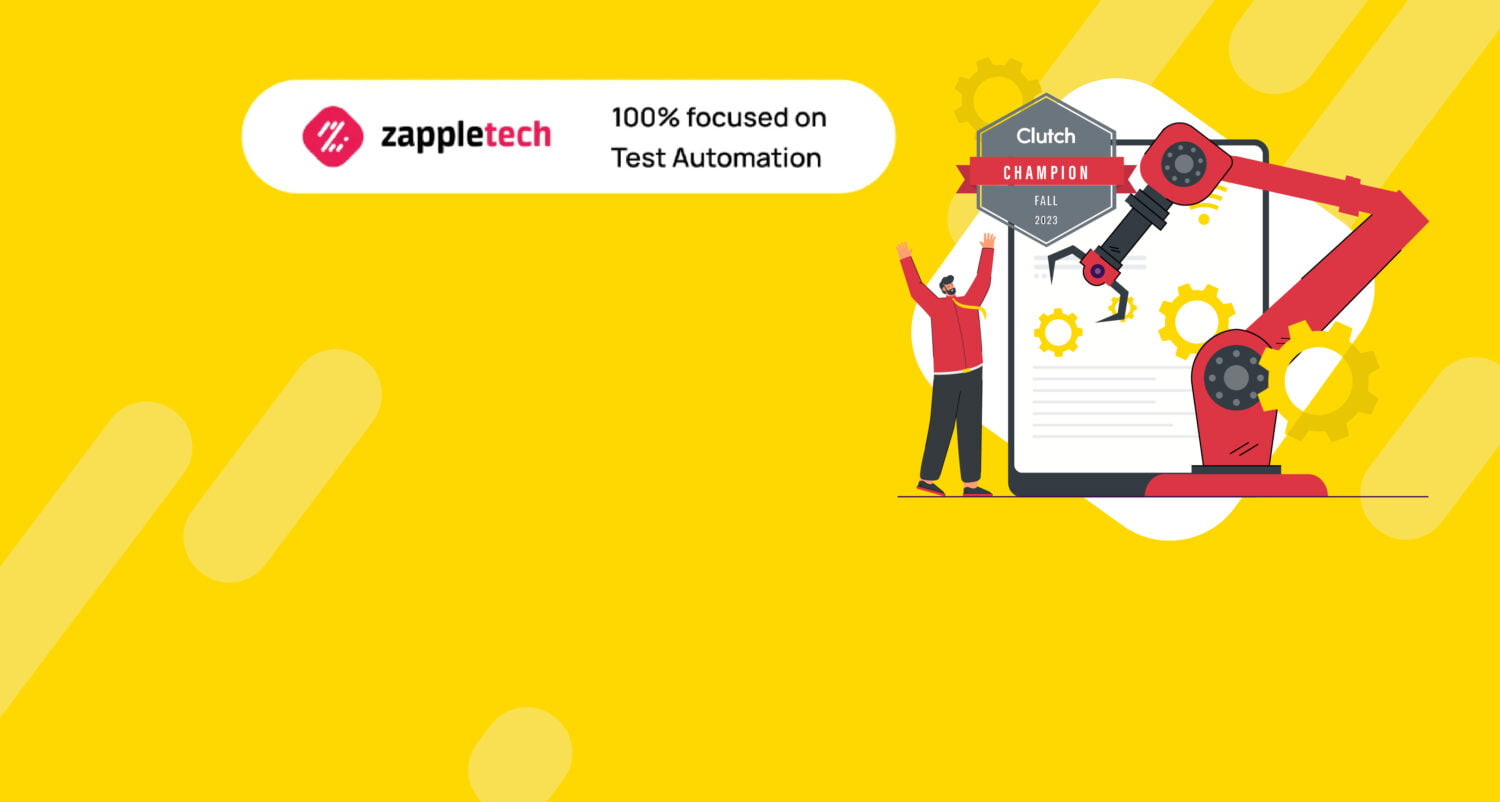Mobile app test automation framework is a key to faster testing, extended test coverage, and better performance of the application.
In today’s rapidly evolving digital landscape, ensuring the seamless performance and functionality of mobile applications is paramount. With the diversity of devices, systems, and user expectations, the need for rigorous testing has never been more critical. Automating mobile app testing has emerged as a crucial strategy for organizations looking to streamline their development processes while enhancing the quality of their products. By leveraging automated tests tools and methodologies, teams can achieve greater efficiency, reliability, and speed in identifying and resolving issues across various mobile platforms.
Mobile applications are more complicated than web ones, they have more users, need to work on a wider device range and more OS variations than testing web apps.Mykhailo PoliarushCEO, ZappleTech Inc.
Automated mobile app testing involves the use of specialized software to execute test cases, compare actual outcomes with expected results, and report discrepancies automatically. This approach not only accelerates the testing cycle but also frees up valuable human resources from repetitive manual testing tasks, allowing them to focus on more complex and creative aspects of app development. Moreover, automated testing ensures consistent test coverage across different devices, screen sizes, thereby improving the overall user experience and reducing time-to-market for new features and updates.
Table of Contents
Specifics of mobile testing
Mobile app testing on multiple devices is more challenging than testing web or desktop ones due to the following reasons:
- Wide variety of screen sizes and hardware characteristics of mobile devices
- Broad variety of mobile devices: smartphones and tabs, different brands, i.e. Samsung, Apple, Xiaomi, HTC etc
- Different mobile systems, their versions and modifications — Android and iOS
- Frequent updates of the systems and the need to constantly test and update the app to ensure that the functionality is not affected.
There are also three types of mobile applications:
- Native applications are built specifically for Android and iOS system. They are corrected directly with the smartphone’s hardware and are faster and more reliable in terms of performance
- Hybrid apps look and feel like native ones, but are compatible with different systems. They are easier to build and maintain, but have slower performance and offer less functionality than native ones
- Mobile web apps are server-side applications used via native mobile browsers. They are developed and tested like web apps.
Types of mobile app testing
There are many types of mobile applications that must work seamlessly at the different types of systems and devices. To come up with the different technical aspects of mobile device testing, several types of mobile app testing are used.
1) Functional testing
It’s the fundamental testing activity in the mobile app development lifecycle. It ensures that all app features work as expected across all devices, systems etc. Functional testing is run real on native mobile apps and devices from the end user’s perspective.
Functional testing is the backbone of mobile app development, serving as the primary method to ensure that all features of an application operate as intended across various devices, operating systems, and user scenarios. This testing phase is critical for validating the functionality, usability, and reliability of the app from the end user’s perspective.
The goals of functional testing:
- To ensure the product’s quality
Functional testing helps the team to catch the potential issues and to fix them before the product is released to the public - Customer satisfaction
This testing type prepares the software for the use of the end-users. It takes into account the ways the customer interacts with the application. With automation, the team can create logical and successive test cases and efficiently manage them - Reducing the risks
If the issue is detected after the product release, defect management becomes far more expensive. Thorough functional testing reduces the risks of failure and saves companies significant amounts of money.
Some functional testing scenarios include the unit and integration testing as well. Usually, functional testing covers the following points:
- Launching and stopping the app
- The use of memory
- Re-launching the app after the interruption
- Interacting with calls and notifications while the app is running
The best practice is to use virtual devices for unit testing and real ones for testing the work of the application.
2) Performance testing
Performance testing is a critical aspect of mobile app development that evaluates how well an application performs under various conditions and stresses. It ensures that the app meets performance requirements and delivers a seamless user experience across different devices, network conditions, and user interactions.
Performance testing checks, how the application works under different conditions. It also does regression testing includes load testing, stress test scripts, testing, spike testing, and volume testing. The following aspects are tested during performance testing:
- App launch (normal — 1-2 seconds)
- Battery consumption
- Memory consumption
- Compatibility with hardware \ other software
- Using network connection
Optimized performance improves the user experience and satisfaction.
3) Compatibility testing
Compatibility testing is crucial to ensure that mobile apps function correctly across various devices, systems, versions, hardware, and software configurations.
It verifies that the application delivers a consistent user experience regardless of these variables. Automating mobile app testing streamlines this process, enhancing efficiency and accuracy in identifying compatibility issues early in the development lifecycle.
Compatibility testing is done test mobile apps to ensure that the mobile application works properly in combination with different devices, systems, versions, hardware, and software. There are several types of compatibility testing:
- Hardware compatibility testing
- Operating system compatibility testing
- Software compatibility testing
- Browser compatibility testing
- Device compatibility testing
- Network testing
- Software version testing
This testing type makes sure that the application correctly interacts with all components of the device.
4) Installation testing
5) Security testing
The sensitive information of the users must be safe and sound. You can take care of this with security and testing mobile apps. There are different types of mobile security testing:
- Penetration testing
This is a fake cyber-attack against the application to detect exploitable vulnerabilities. Penetration testing involves the breach of different app systems: APIs, frontend \ backend servers to find vulnerabilities that can be subject to code injection attacks. - Vulnerability testing
This is an automated surface-level identification of security breaches in the app environment.
6) Real user condition testing
Real user condition testing, also known as real-world testing, is crucial for validating the functionality and performance of mobile apps across diverse and realistic usage scenarios. Unlike controlled lab environments, this testing approach evaluates how the app behaves in actual user conditions, which may vary in terms of network connectivity, device capabilities, geographical locations, and user behaviors.
You are to ensure that basic functionality of your app works properly in all conditions, not only in ideal ones. Real user condition testing includes the usability testing of following things:
- Connection loss
- Screen rotation
- Conflicting applications
- Low battery charge
- Interrupting the app by incoming calls, messages, push notifications
This will give you a true look at the experience of the end-user.
7) Accessibility testing
Accessibility testing ensures that mobile applications are usable by all individuals, including those with disabilities such as vision impairments, color blindness, hearing difficulties, and physical or cognitive limitations. This testing focuses on verifying that the app’s design, functionality, and content are accessible and navigable for users who rely on assistive technologies like screen readers, voice commands, and alternative input methods.
This testing type makes sure that the application can be used by all users, including those with disabilities — vision or color blinding, hearing, other physical and cognitive conditions. It includes the following things:
- Color contrast
- Compatibility with screen magnification software
- Speech recognition
- Special keyboard
Making the app accessible to all groups of users will improve the reputation of the company and even help to avoid fines.
How to start automating mobile app testing
To get started with mobile app testing, you need to develop a first exploratory testing strategy. Only in this case, the automated tests and process will be smooth, and the coverage and efficiency will be the highest. Now we will give you a brief algorithm for developing a test strategy for mobile app automation testing.
1) Gather testing requirements
This is the first thing to do before developing the automation strategy. Without a clear understanding of what needs to be manual and automated in mobile app tests process, it is impossible to create the test plan and to design the entire strategy.
During requirements gathering device testing, the team decides on using the devices for testing, simulators \ emulators, the system versions, systems, and versions of software. This will help the developers team to handle the commands, integrations, processes, and improve the collaboration between the development and QA team.
2) Create test plan
At the test planning stage, you will decide on what you will actually do. A good test plan should contain the test objectives and scope, the required resources (people, software, and hardware), and the test schedule.
At the planning stage, you should prioritize the test cases that will be run. Not all test cases are equally important.
3) Decide what can be automated
Actually, the more you automate, the better. Due to test automation, you will reduce the time-to-market of your software. But, do not automate the tests that the manual testing or QA engineer can do cheaper or more efficiently.
Top 3 testing types to automate:
- Unit testing
Unit tests should be the highest priority for your automation since they are fast, easy to debug and reusable. - Integration testing
Here you check that all modules of your application interact as expected. Integration testing is done during all development cycles, and its automation will save you a great amount of time - Functional testing
The main point of any application is the correct work of all its functionality. For functional testing, there is a great number of frameworks that will match your codebase.
4) Have a defect management system
With a bug tracking system, you will be able to centralize the test repository and assign the tasks. If your project is more sophisticated, with a lot of configurations, workflows, and data set, issue tracking functionality might limit you. In this case, you’d better invest in a test management system.
5) Simplify test reporting & analysis process
A test reporting system will help you to present your test results in a structured way. You will be able to see the test coverage and make sure that all the bugs have been fixed. The test report tools will present the analytics of the testing process with diagrams and tables that will point out the challenges both in the development and testing process.
Top 5 test automation frameworks for mobile testing
For you, we have prepared an overview of five automation testing frameworks for both Android devices and iOS applications.
Browserstack
Browserstack is a web & mobile testing platform that gives the opportunity to test the websites, mobile apps across all browsers, systems, mobile devices, and emulators. It allows running hundreds of mobile testing automation tools simultaneously, debugging with video recordings, automated screenshots, and logs cross-browser testing.

Benefits:
- Able to run location-specific testing
- Emulates any browser, device, or system
- Supports cross-browser and cross-platform testing
- Stable performance
- Intuitive interface, smooth learning curve
Drawbacks:
- Doesn’t have a mobile version
- Consumes many resources
- High price
- No live chat support
XCUI Test
XCUITest is an open-source testing framework developed by Apple for iOS UI test automation. It is used for testing the interface of native iOS applications built on Swift or Objective-C language. It can run both on simulators and real devices.

Benefits:
- Doesn’t need to install anything
- Intuitive environment
- Direct support \ update by Apple
- Rich documentation and tutorials designed by Apple
- Speed of work
- Test recorder
Drawbacks:
- Doesn’t support cross-platform testing
- Strong iOS development skills are required
- Test recorder supports only basic actions
- The framework is developer-orientated
Appium
Appium is an open-source automation framework that supports all types of mobile apps: web, hybrid, and native apps. It has a client-server architecture and a standard API — so, the code written with Appium doesn’t require recompilation or altering.

Benefits:
- Supports the majority of programming languages (Java, Ruby, Python, PHP, Javascript, С#
- Supports automation on physical devices and simulators
- Can be integrated into CI\CD process
- Compatible with Selenium
- Rich documentation
Drawbacks:
- Slow launching
- Synchronization issues
- Long installation process
Espresso
Espresso is an Android testing framework that follows test-driven development. It offers a simple API testing, that is easy to learn and that is updated along with new Android versions.

Benefits:
- Frequent updates and support of the newest Android versions
- Automatic synchronization
- Simple workflow and fast feedback
- Easy integration with Android studio
Drawbacks:
- Supports only Java programming language
- App source code is required
- Doesn’t support cross-platform testing
Robotium
Robotium is an open-source testing environment for writing automation tests for Android applications. It has full support for native and hybrid apps. With Robotium, it’s possible to write thorough testing scenarios for functional, system, and acceptance for testing mobile applications that span numerous Android activities.

Benefits:
- Fast writing of short test cases
- Automatic synchronization
- Fast test execution
- Automatic decision-making
- Supports both the apps with source codes and APK-files
Drawbacks:
- Can’t process Flash and web-components
- Processes only one app at a time
- Can’t imitate the work with programmatic keyboard
- Can’t interact with notifications
- Slow performance on old devices
Balancing costs and resources: the In-house vs. Outsourced dilemma in mobile app testing
If you plan to conduct automated mobile app testing, you’ve likely pondered whether to implement the project with an in-house team or delegate it to outsourcing. Both options have their benefits, and you can even combine them, for instance, by hiring a QA team and assigning them a portion of the project.
However, the first step is to determine whether involving an in-house team for testing, especially automation, is even advisable. Next, we’ll outline the advantages of each approach and help you decide which one best suits your needs.
Advantages of in-house testing
Among the strengths of internal QA, you can highlight the following:
- Team motivation.
- Understanding project goals and specifications.
- Knowledge of current development issues.
- Industry-specific skills.
- Minimal staff turnover.
In other words, your internal team is the support you can always rely on. Experts work diligently and fulfill their duties. However, their experience or skills may often fall short. This is why there’s a need for additional, specialized experts.
Advantages of collaborating with external contractors
By hiring external specialists, you get:
- A broad range of skills.
- Experience across multiple industries.
- Understanding of QA principles and methodologies, including automation.
- Self-organization and discipline.
- Flexible payment arrangements.
Moreover, you can save time and resources by delivering the project on time with the highest possible quality of the digital product. The expertise of experts from an external automation testing company is often superior to that of internal staff due to their exposure to diverse projects.
Why is outsourcing ultimately better?
Comparing advantages, at first glance, both options seem optimal. And that’s true if not delving deeper into the matter. Objectively, by hiring external experts, you gain the following advantages:
- Minimized costs for office space, equipment, and technology.
- Higher efficiency, as experts will perform only the specified tasks.
- Improved process quality. Not only testing but also work organization, reporting, etc.
- Flexible billing. Instead of paying salaries to full-time employees, you pay for actual work done.
- Autonomy. External contractors aren’t tied to internal schedules but adhere to deadlines, meeting schedules, and more.
Language barriers and the geographic location of the outsourcing team no longer matter.
You won’t face communication or process control issues thanks to CI/CD tools and the adaptability of experts.Mikhail BodnarchukCDO, ZappleTech Inc.
However, this is true only if you’ve chosen the right QA service provider.
Tips for choosing a good contractor
The search for a team providing mobile automation testing services often becomes problematic. This is because the modern market is flooded with offers from completely different companies. Most of them conscientiously carry out their duties, but some simply freeload, providing services of meager quality.
Next, we’ll tell you how to distinguish experts from dishonest teams and how to choose a truly professional team that will excel in your QA project.
Balancing quality and service costs
A company from Canada might set a price tag that often equals the development cost. However, the quality of the service will correspondingly be high. On the other hand, testers from India or Asia might work almost for free, but you might encounter certain issues with them (not always). Is there an ideal solution? Certainly, teams based in Europe.
By collaborating with experts like ZappleTech, you’re guaranteed to receive high-quality services at reasonable costs.
Experience with similar projects
Portfolios, blog materials, or simply service pages on a website are optimal indicators of the industries testers specialize in. Just visit the team’s resources and review their cases under the “Expertise” section. There, you’ll find a list of industries they have experience working with.
Client reviews
The final method of identifying the team’s skill level is platforms like G2. On such resources, companies’ profiles are published, and clients can leave reviews about their collaboration in the relevant section. Here, you’ll find relevant information about the potential performers’ expertise in your QA project.
However, don’t forget that these platforms often serve as brand promotion, so some reviews might be “rating manipulation.” And in general, if you don’t want to spend your time and nerves sifting through hundreds of proposals, we have the perfect solution for you. Namely, the services of the ZappleTech team.
Why is it better to order this kind of service in company ZappleTech?
By collaborating with ZappleTech experts, you’re guaranteed high-quality services at a personalized price. The company has been in the market for over 10 years, during which it has executed nearly 100 QA projects of varying scales and types.
Automation testing, IT solution analysis, consulting, and other services await you.
Get in touch with the team’s manager, describe your problem, and receive a detailed consultation, a project cost estimate, and recommendations for its implementation. And, accordingly, choose the desired service.







